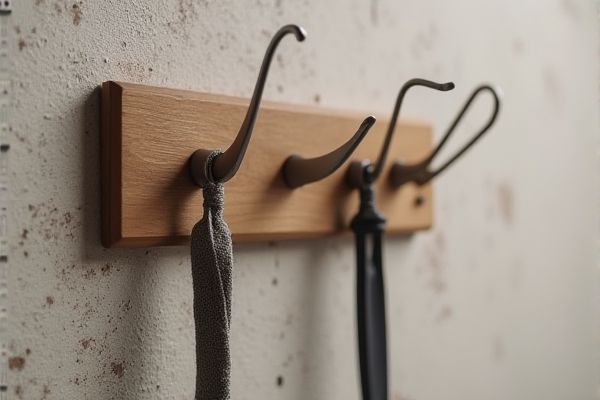
Single hooks provide a minimalist grip and are ideal for lighter loads, while double hooks offer enhanced security by distributing weight more evenly, making them suitable for heavier or more complex tasks. Explore the differences in function, strength, and applications to determine which tool best suits Your needs.
Table of Comparison
| Feature | Single Hook | Double Hook |
|---|---|---|
| Design | One hook for holding items | Two hooks for additional holding capacity |
| Weight Capacity | Supports moderate weight | Supports heavier or multiple items |
| Usage | Ideal for light tools or single items | Suitable for heavier or paired tools |
| Space Efficiency | Uses less space | Offers more organizing space |
| Stability | Good stability | Enhanced stability for heavy loads |
| Cost | Generally lower cost | Usually higher cost |
Introduction to Single Hook vs Double Hook Tools
Single hook tools feature one hook, offering precision in gripping and lifting tasks, ideal for managing lighter loads and delicate materials. Double hook tools provide enhanced stability and balance by using two hooks, making them suitable for heavier loads and more secure handling in industrial applications. Selecting between single and double hook tools depends on the specific requirements of load capacity, safety, and operational control.
Key Differences Between Single and Double Hooks
Single hooks feature one point, offering easier penetration and less damage to the catch, making them ideal for catch and release fishing. Double hooks consist of two points joined by a shank, providing increased hooking efficiency and security, especially useful for larger or aggressive fish. The choice between single and double hooks depends on the target species, fishing technique, and conservation preferences.
Applications of Single Hook Tools
Single hook tools excel in precision tasks such as jewelry making, wire wrapping, and delicate textile work, where controlled manipulation is essential. Their streamlined design allows for easy insertion into tight spaces and minimizes material damage, making them ideal for intricate crafting and repair jobs. You benefit from enhanced accuracy and reduced material stress when using single hook tools for specialized applications.
Uses of Double Hook Tools
Double hook tools provide enhanced grip and stability when lifting or pulling heavy, irregular, or slippery objects, making them ideal for construction and rigging applications. Their dual points of contact distribute force more evenly, reducing the risk of slippage compared to single hook tools. Commonly used in industrial settings, double hook tools improve safety and efficiency when handling materials requiring secure attachment.
Advantages of Single Hook Tools
Single hook tools offer enhanced precision and control, making them ideal for delicate or detailed tasks. Their simpler design reduces the risk of material damage and allows easier maneuverability in tight spaces. Lightweight and efficient, single hook tools improve user comfort and reduce fatigue during extended use.
Benefits of Double Hook Tools
Double hook tools provide enhanced grip and stability, reducing slippage during heavy-duty lifting or pulling tasks. Their dual points of contact distribute force more evenly, minimizing material damage and increasing safety for operators. Increased versatility allows double hook tools to handle a wider range of applications compared to single hook designs.
Choosing the Right Hook Tool for Your Needs
Selecting the right hook tool depends on the specific application, where single hooks excel in precision tasks like jewelry making and delicate lifting, while double hooks offer enhanced stability and load distribution for heavier or bulkier items. Considering the weight capacity and material compatibility ensures optimal performance and safety during use. Evaluating task requirements and ergonomic factors helps in choosing between single or double hook designs, maximizing efficiency and user comfort.
Safety Considerations for Single and Double Hooks
Single hooks offer simplicity and ease of use, but may pose higher risks of accidental detachment under heavy loads or dynamic movements, requiring vigilant inspection and secure attachment. Double hooks provide enhanced safety by distributing load forces evenly and reducing the chance of slippage or disconnection, making them preferable for critical lifting or rigging applications. Ensuring your choice between single and double hooks aligns with load capacity, environmental conditions, and regulatory safety standards is essential for preventing workplace accidents.
Maintenance Tips for Hook Tools
Single hook and double hook tools require regular maintenance for optimal performance and longevity. Clean hooks after each use to prevent rust and remove debris, while inspecting for any signs of wear or bending that could affect their efficiency. You should also apply a light coat of oil to protect metal surfaces and store hooks in a dry, organized environment to maintain their sharpness and durability.
Frequently Asked Questions about Hook Tools
Single hooks provide a lightweight, versatile option for tasks requiring precise grip and minimal penetration, commonly used in upholstery or light material handling. Double hooks offer enhanced stability and grip, making them ideal for heavy-duty applications like lifting or securing bulky items, reducing the risk of slippage. Your choice between single and double hooks depends on the specific task requirements, load capacity, and material type involved.
 homyna.com
homyna.com